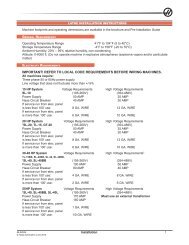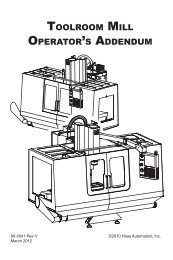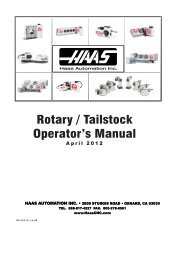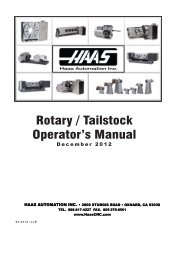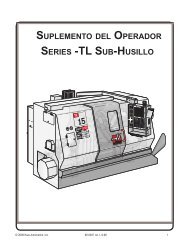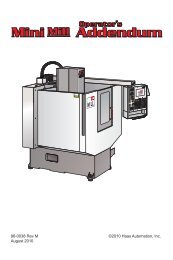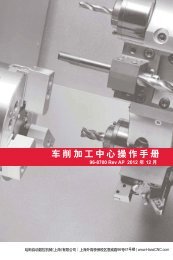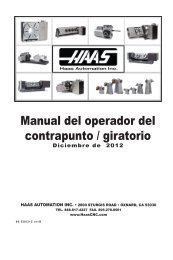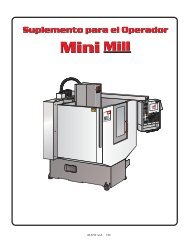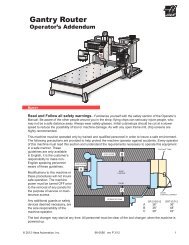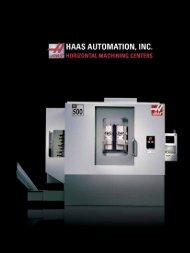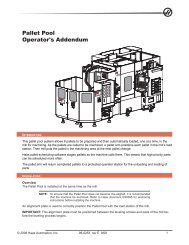Vertical mill installation instructions - Haas Automation, Inc.
Vertical mill installation instructions - Haas Automation, Inc.
Vertical mill installation instructions - Haas Automation, Inc.
You also want an ePaper? Increase the reach of your titles
YUMPU automatically turns print PDFs into web optimized ePapers that Google loves.
2. Remove the front Y-axis way cover bottom cover and the way cover support bars to allow access for<br />
properly tightening of the connecting screws.<br />
3. Before inserting and tightening all the connecting screws, recheck the table level to be certain that the<br />
leveling process of the column base did not affect table level.<br />
4. Tighten the connecting screws with lock washers in place and loctite on the screws.<br />
Geometry Check After Mating the Two Bases<br />
Before continuing two fundamental geometry checks need to be made. The first is the perpendicularity of the<br />
X-axis to the Y-axis, and the second is to verify the sweep of the Z-axis.<br />
1. X-axis to Y-axis sweep is accomplished using a granite square. Set zero by sweeping the Y-axis on one<br />
side of the square, and then to verify that the motion of the X-axis is perpendicular by sweeping the adjacent<br />
side of the square. If the X and Y axes are out of tolerance, there almost certainly is contamination or damage<br />
between the mating flange surfaces that is creating this error. The assembly will have to be disassembled, the<br />
surfaces re-stoned and cleaned, and the entire leveling/squaring process repeated to this point.<br />
2. Verify the sweep of the Z-axis by repeating the previous section (“Sweeping the Z-Axis”).<br />
Fine Leveling the Machine<br />
Now that the preliminary leveling is done and the bases are securely mated, the machine can be treated as<br />
a unit with confidence that the geometry will be maintained as long as adequate control is maintained in the<br />
fine leveling process. The process begins with loading the remainder of the leveling screws very lightly and<br />
working into an equally loaded situation that does not affect the geometry already achieved.<br />
The column base is affected first, and is fine leveled with respect to the table at the middle of travel.<br />
CAUTION! Do not rush the leveling process. Any drastic attempt to fine level the column<br />
base will be propagated to the table base assembly and may not be correctable<br />
if not addressed early in the process.<br />
The table base is more complicated to fine level, and small steps will be taken to preserve the level to earth<br />
established at the middle of travel. The first step of the process will be to begin to load the leveling screws<br />
over the length of the base. The second step will be to begin to pull the overall length into earth level. The<br />
third step will be to fully pull the base into level.<br />
1. Begin with the column base assembly. Place the level on the spindle head parallel to the Y-axis and run the<br />
column through the range of travel. If no deviation in the reading exists, the column base is flat in the direction<br />
of the Y-axis. Move the level to each linear guide surface in front of the column. If the readings are zero, the<br />
column is flat to earth in the direction of the Y-axis. Power up the control. Place the level on the spindle head<br />
parallel to the X-axis. Run the column through the range of travel. If no deviation in the reading exists, the<br />
column base has no twist. Place the granite parallels across the linear guide surfaces in front and behind<br />
the column. Place the levels on the granite. If the readings are zero, the column base is flat to earth in the<br />
X-direction.<br />
2. Move the levels to the table and place them as close to the center as possible. One level should be parallel<br />
to the X-axis and one level should be perpendicular to the X-axis. If the readings are still zero, then the table<br />
at the center of travel is still level to earth.<br />
3. If any deviations exist, they need to be corrected at this time. If the deviations are very small, the mating<br />
flange of the two bases does not need to be unscrewed. If the deviations are very large, attempting to correct<br />
the level may induce a large stress in the assembly that will not allow earth level to be fully achieved. It is<br />
important for the geometry of the machine that earth level be achieved.<br />
The table at center of travel is now known to be at earth level and the column base is also at earth level. The<br />
process of extending that level over the travel of the X-axis may now begin by starting to load the remainder<br />
of the leveling screws.<br />
4. Lower the remainder of the table base leveling screws to touch off on the leveling pads below.<br />
30 Installation 96-0284A<br />
© <strong>Haas</strong> <strong>Automation</strong> June 2010



